The Gift of South Dakota
Subscriptions to South Dakota Magazine make great gifts!
Subscribe today — 1 year (6 issues) is just $29!
Form First
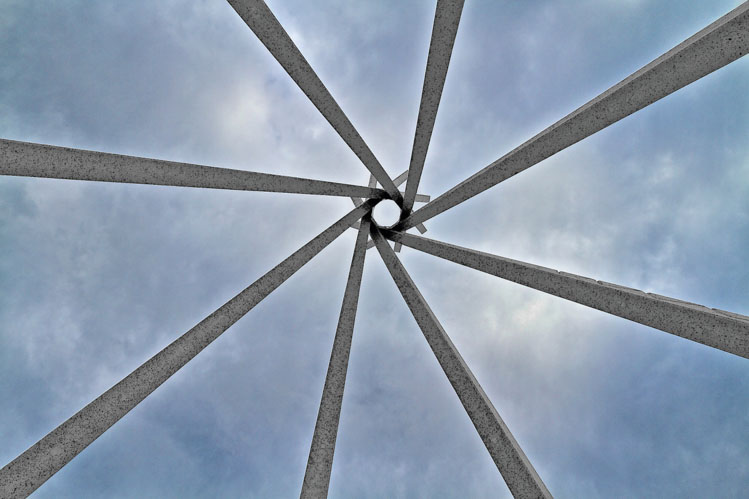 |
| Ward Whitwam's lodge pole tipis stand at several rest stops around South Dakota, including this one at Chamberlain. Whitwam, a longtime South Dakota architect, died January 25. Photo by John Mitchell. |
Editor’s Note: Renowned South Dakota architect Ward Whitwam passed away on January 25 at age 97. South Dakota Magazine featured Whitwam, perhaps best known for his concrete tipis placed at rest stops across the state, in our September/October 2003 issue.
Ward Whitwam bustles, yes, bustles through his cluttered office on the second floor of the Security Building in downtown Sioux Falls. It’s Monday. He’s finished his design for the governor’s mansion competition. He’s training an 18-year-old to run the computer for the South Dakota chapter of the American Institute of Architects, which he serves as executive director. He’s a little late for an interview. “I’m busy,” Whitwam says with a grin. “Isn’t it wonderful?”
At nearly 80, Whitwam, whip thin in his white jeans, white shoes and red shirt, all topped by inquisitive blue eyes and a shock of white hair, has a hard time slowing down or even sitting still.
Retire? “I can’t foresee it,” he says. Not while his health holds. Not when the ideas still run strong. Anyone who’s traveled in South Dakota has seen the results of this active brain. Whitwam designed the towering concrete tipis — the largest of the concrete lodge poles are 56 feet long and weigh 6.5 tons — at seven of South Dakota’s Interstate rest stops. He also designed the Lewis & Clark Interpretative Center in Chamberlain with the longboat balcony overlooking the Missouri River, the arched office building on West Avenue in Sioux Falls, and the soaring, round balconies at the Good Samaritan nursing home on north Minnesota Avenue.
After 50 years in the business, Whitwam could be excused for slowing down. But the ideas keep coming. “His mind goes a mile a minute,” says architect Gene Murphy, who went to work for Whitwam in 1967, later bought the business, and continues to team with Whitwam for projects such as the Chamberlain rest stop, Sioux Falls Fire Station No. 6 and the governor’s residence competition. “I’m sure he stays awake at night thinking about these designs. He’s really fun to work with, and he works fast, and he expects other people to keep up with him.”
The bottom line is that her husband believes part of life is what you do, says Elissa Whitwam, who married Ward 44 years ago. Besides, he doesn’t have any hobbies. If Whitwam were to stay home, he’d have nothing to do but clean the garage.
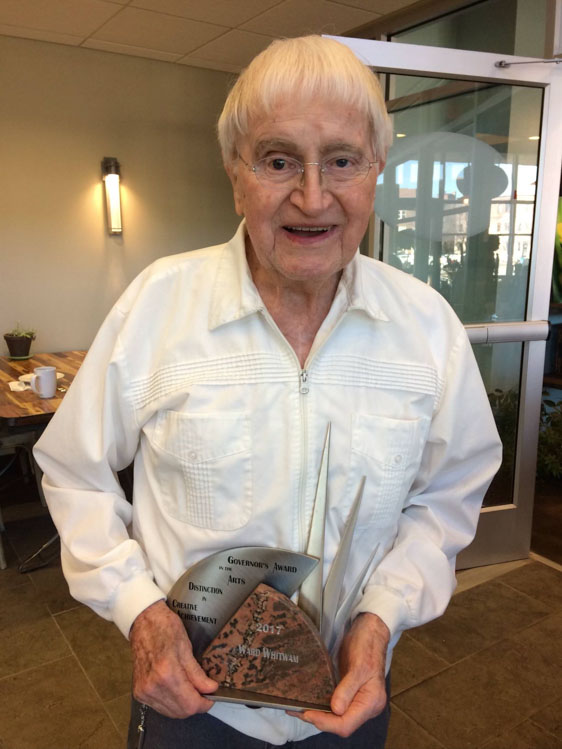 |
| In 2017, Whitwam received a Governor's Award in the Arts for Distinction in Creative Achievement. |
It’s in his genes, Elissa Whitwam says. It’s his way of thinking. Having an office outside the home is also the best thing for a marriage, says the woman who one quickly suspects has been and remains her husband’s biggest fan.
The challenge to design South Dakota rest stops came early in Whitwam’s career. It was the mid-1960s, when South Dakota was just building its Interstate highways. Lady Bird Johnson had launched her campaign to beautify America’s highway system. Congress approved a highway beautification law that came with funds attached to pay for approved projects.
The way Whitwam tells it, he and highway director John E. Olson went to the same Sioux Falls church. When Olson asked him if he wanted to design some rest stops, he said yes. Whitwam knew he wanted to say something about the past. The lodge pole design came to him during a meeting in Minneapolis. He remembers he was bored, and his mind wandered. “I sat there and I sketched,” he says. He kept wanting to show settlers, but he realized the American Indians had been here first. So the lodge poles — the poles the Lakota used to support tipis — emerged. When Whitwam took a model to the highway department, he says, they just stared.
The highway commission accepted Whitwam’s proposal in November 1965. “We think this design is far superior to park designs of other states because it is not only attractive but has historical appeal as well,” said highway commissioner J.W. Burns, according to an Argus Leader report. Burns found the design “South Dakota in concept,” reflecting the many cultural influences of the Sioux Indians of the state.
Whitwam, however, admits he did not know how he would connect the massive concrete poles that would form the tipi structure. That’s where Wilfred Schroeder, Marvin Heck (who worked for Gage Brothers Concrete), and Heck’s son, Richard, came in. Schroeder was in charge of structural design. “I guess the hardest thing was the fitting of them together,” Schroeder said, giving Richard Heck, now a Minneapolis architect, credit for doing most of the math. Marvin Heck knew the slots and positioning of the weld plates had to be precise to make the system work. Once they’d figured out where to connect the poles, where to place the metal flaps that would be used to weld them together and where the beams would settle against each other — “they just fit together like a glove,” Heck said.
Since the eight poles rest on each other for support, they wouldn’t stand until all were in place, Schroeder said. Each tipi was built around a temporary middle pole that was removed when the big beams were welded in place.
The first lodge poles were 40 feet long; later ones are 56 feet. The first rest stop tipi was finished in 1969 at Wasta. Six more tipis followed, at Chamberlain, at New Effington near the North Dakota border, at Salem, Spearfish, Valley Springs and Vermillion. “I know there were a lot of comments about them,” Schroeder remembers.
Even today, when South Dakotans and cross-country travelers take the Interstates for granted, people talk about the tipis. So many asked questions that the South Dakota tourism department printed a card giving the tipi dimensions.
The lodge pole rest stops are undoubtedly Whitwam’s most recognized work. They were, however, only one stop for a man who almost always knew he wanted to be an architect.
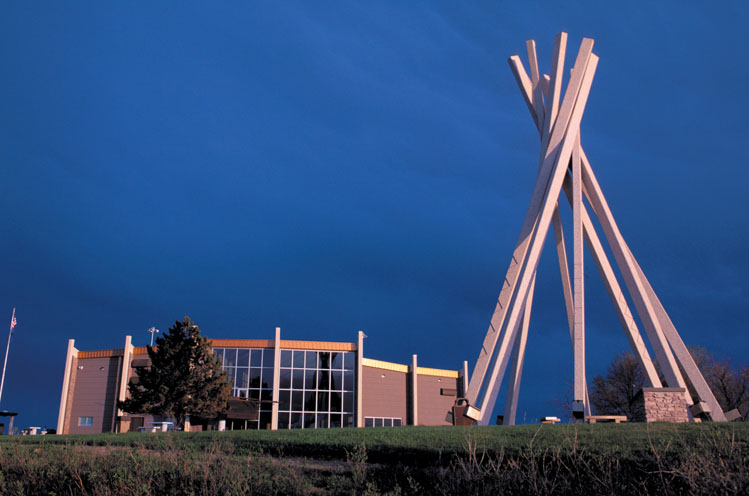 |
| The Lewis and Clark Interpretive Center at Chamberlain. |
Whitwam was born Dec. 12, 1923, in Watertown. His father was president of Park-Grant Warehouse Groceries and started the Prairie Markets. Merle Whitwam had wanted to be an engineer, but took up the family business when his father died young. He told his two sons, “I want you boys to do what you want to do.”
By the time he was 14, Ward Whitwam was reading Architectural Record, and had discovered Frank Lloyd Wright’s just-completed Fallingwater — the Pennsylvania home built over a waterfall. Whitwam’s future was clinched. “A lot of young people want to be architects,” he says. “It doesn’t pay well, but it’s certainly fun.”
Whitwam followed his brother to the University of California at Berkeley. “I was 17 years old, a child,” he said. “I really was homesick and shouldn’t have left my mommy and daddy.” The South Dakota boy was also a good subject for ridicule until he won first prize on his first design job. “Suddenly, I had people talking to me,” he remembers.
At 18, he was drafted into the Army and sent to Louisiana, still a “soft city boy.” His job was to help build a “corduroy road,” but he would rather have told others how to build it instead of building it himself. He traveled with 19,000 other soldiers to England on the Queen Mary, landing Aug. 1, 1943, as a member of the 1172nd Engineer Combat Group.
By 1945, Whitwam was back at Berkeley, finishing his undergraduate degree in 1948. He took a year’s break in Aberdeen, where the architect he worked for fired him, telling him he was arrogant, conceited and egotistical. Whitwam returned to California to finish his master’s degree and a three-year apprenticeship and to pass his professional exam. He opened his office in Sioux Falls in November 1953.
The young architect soon had business. In coming years, he would design 22 nursing homes, mostly for the Good Samaritan Society, several Land-o-Lakes dairy buildings, office buildings, homes, rest stops, four churches in Luverne, Minnesota (Catholic, United Reformed, United Methodist and Baptist) and the Augustana University Chapel of Reconciliation in Sioux Falls. Churches are the most fun, Whitwam says. “It’s not a box, and you get a chance to express yourself a little more.”
Whitwam never strayed far from his early love of Frank Lloyd Wright’s work and that of the Prairie School of Architecture. “Everything is a matter of proportions,” he says. Prairie architecture should be “slender architecture.” He still lists Wright’s Fallingwater and Taliesen East among his favorite buildings, along with the Lever Brothers Building in New York City and the Albert Dow home in Midland, Michigan.
“There’s too much fat around here,” he said. Not known for pulling his punches, Whitwam would never put stripes on a fat woman or on the downtown Sioux Falls Qwest building. He would never build the massive Dow Rummel addition on West Avenue, a street of one-story buildings. “Thickness is not good architecture,” Whitwam says. “You can’t have a big, fat house and have it look nice.”
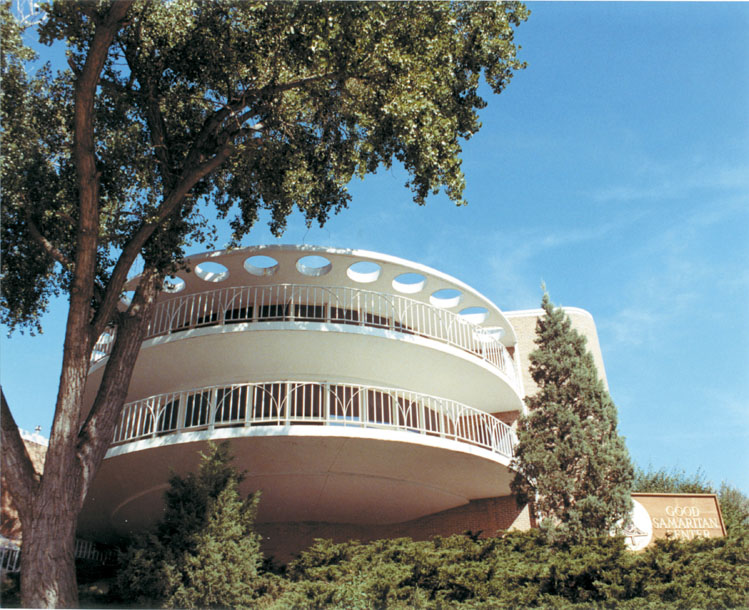 |
| The Good Samaritan Society's Sioux Falls Center. |
When he designed the Augustana chapel with its double roofline, Whitwam knew the school could not afford a campanile, so he designed height in the rooflines. He wanted to create grandeur without a box. He loves roofs anyway. When the period of roofs came in, he was in his glory, he says.
Whitwam never accepted some common architectural rules, such as the one laid down in 1896 by Louis Henri Sullivan: “Form ever follows function.”
“I never bought it,” says the man who still believes in form first. “I want things to look nice, then I squeeze something into it.”
Whitwam likes to stay current and to experiment with materials. He likes adventurous architecture, said Sioux Falls artist Robert Aldern, who sees one of Whitwam’s greatest strengths as his ability to combine visual arts and architecture. “He’s one of the few architects who makes an issue out of that. It’s hard to have a client and talk about the money it takes to build a building these days, then talk them into adding architectural art forms to it.”
Aldern’s laser cut metal panels of South Dakota’s history are included in the Chamberlain rest stop. So are artist Carl Grupp’s decorative rolling gate and the massive nets Elissa Whitwam made using 800,000 beads. Whitwam added the 55-foot keelboat, which extends outside the building as a balcony where visitors gaze down at the Missouri River below the bluff. “It’s not a simple thing to involve art with architecture, but I think it’s a very wonderful thing that we have architects in the community that do,” Aldern said.
Pushing 80, Whitwam remains dedicated to architecture, says associate Gene Murphy. That’s why he continues to lead the state’s architect group. That’s why he continues to design. That’s why he was chosen as a member of the American Institute of Architect’s College of Fellows, becoming only the third South Dakotan selected for the honor in the last 20 years.
Being involved has meant more than architecture for Whitwam. He’s been a community activist, sometimes a gadfly. Before he married, he spent more than a decade as a Hi-Y leader, a position that left a legacy of trees lining West Avenue in Sioux Falls. Bruce Halverson, former president of Augustana University, was one of Whitwam’s Hi-Y members.
Halverson was a sophomore at Washington High School in 1959 when he joined the popular Hi-Y for social and athletic activities. “For three years, [Whitwam] was our mentor, our leader and a wonderfully supportive guide to this group of young men as we worked our way through high school,” Halverson said. The students were full of energy and enthusiasm, which Whitwam supported, providing good advice and guidance — and he wasn’t a parent.
When Halverson was a senior, Sioux Falls hosted its first State B basketball tournament, and Whitwam’s Hi-Y group planned social activities to go with it. They charged a dollar for admission to a dance, and made thousands. “One of the great images is of people standing around with money in every pocket of their trousers,” Halverson remembers. “Ward then said to us: ‘We need to put this to a good use.’” The group bought a trophy case for the YMCA, and Whitwam convinced them to spend the rest of the money on 63 trees for West Avenue.
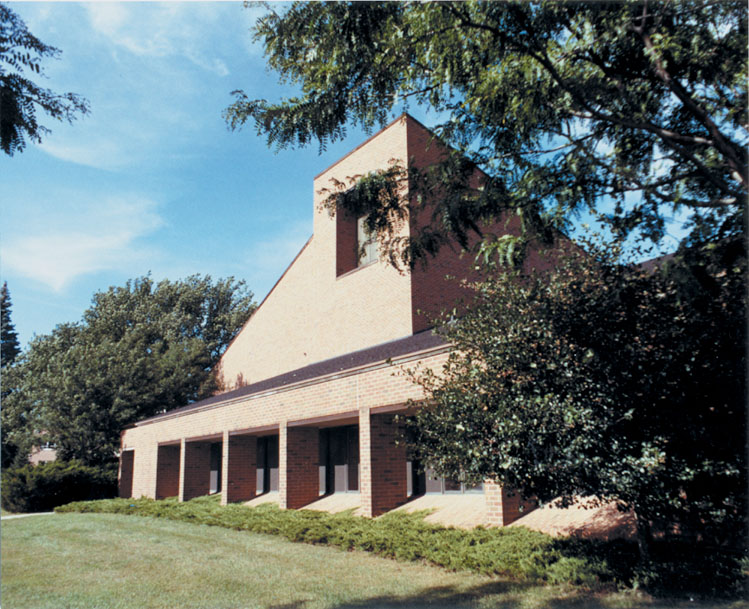 |
| The Chapel of Reconciliation at Augustana University in Sioux Falls. |
What Whitwam forgot was that the Hi-Y members would graduate and go to college. So he took care of the trees for the next decade, teaching his sons to drive the water truck until he convinced the city to take over maintenance. “I’m reminded of it every time I go to an Augustana football game,” Halverson said. Whitwam has a tremendous spark for life. “He genuinely cares about people of all ages. He’s got a curiosity about life.”
Elissa Whitwam met that spark when she came home from Washington, D.C., because her father was ill. A friend invited her to help with a Thanksgiving brunch at the First Congregational Church, and that’s where she met Ward. She returned from Washington again when her father died the following February, expecting to stay at least a year with her mother. “In May, he finally asked me out,” she said. “I was busy.”
He protests but adds with a grin, “I had to check her out to see if she had any money.”
Elissa married Ward Whitwam because he knew what he wanted in life. “A lot of guys you meet don’t need a wife, they need a mother,” she said. “This guy didn’t need a mother.”
The Whitwams were married in October 1959. They had two boys, Wayne and Bryce, and a daughter, Elise. Whitwam designed a modified A-frame home for the family on the edge of a ravine in 1965. To visit the home is to leave Sioux Falls behind for the woods outside their front door.
Whitwam wanted the house spaces to be simple, the feeling open. The sloping roof peaks at 14 feet above the first floor; he painted the ceiling black, then lined it with walnut planks finished with Danish oil. The wood — he bought it for $200 from a family in Mission Hill — is put together like a puzzle, with black showing between the planks. The sloping ceiling sets the tone for the living room, kitchen and master bedroom. Windows fill the end wall of the living room, reaching to the peak.
The balcony outside is surrounded by trees. Whitwam also designed the dining room lamp, then had it made of blue and green Mexican glass cylinders, long filaments and wrought iron. In the bathroom, he designed a mirror that rolls to hide the medicine cabinet.
From this refuge, Whitwam goes forth to work and travel. “Slow down” has never been part of the picture. “Ward had this cancer and the heart thing,” Elissa says. “To him, it’s all a mistake.”
Retire? The question is obviously silly to this octogenarian. “I can’t foresee it,” says the man who still has much to do.




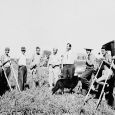





Comments